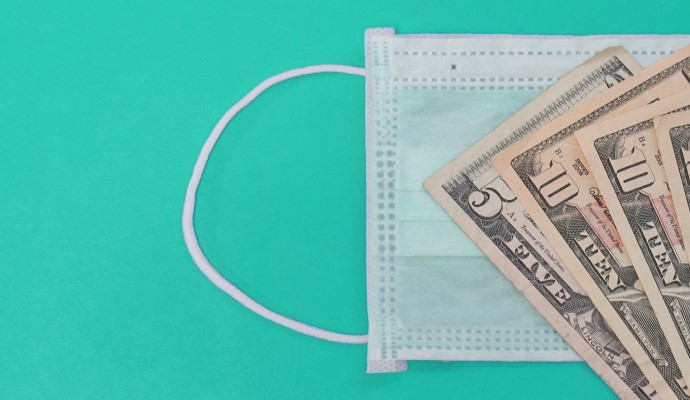Slow Hospital Visit Recovery Suggests Telehealth Here to Stay
Hospital visit recovery across key metrics is still down compared to pre-pandemic levels, and new consumer research suggests volumes could stay low as patients prefer telehealth services.

Source: Getty Images
- Hospital visit recovery may be hitting another bump in the road as new consumer research indicates that patients prefer telehealth services and other alternative care options.
The new data from TransUnion Healthcare recently showed that, generally, hospital visit volumes have stayed consistent through late October after plateauing in July. As of the last week in October, emergency department visits were down by 26 percent compared to pre-pandemic levels and just one-basis point lower ten weeks prior.
Inpatient volumes were also down by 9 percent compared to pre-pandemic levels and also one-basis point lower than the volumes observed in mid-August.
Outpatient visits, on the other hand, have recovered and remained around pre-pandemic levels by late October.
Low hospital visit levels, especially on the emergency department side, may be attributed to “the continued, dramatic reduction in visits from children and patients with lower-acuity diagnoses (including cough and ear pain)” but it would also point to a larger trend toward telehealth and non-hospital care, according to new consumer research.
READ MORE: Healthcare Revenue Cycle Recovery After the COVID-19 Pandemic
Telehealth services commonly replaced an office visit with a primary care physicians and some patients even used the virtual care services instead of going to the emergency department, TransUnion Healthcare reported in a follow-up survey of over 1,300 telehealth patients.
A previous survey had found one-third (33 percent) of patients utilized telehealth in the last year, and six in 10 (59 percent) used the service because of the pandemic, TransUnion Healthcare reported.
In the follow-up survey, 60 percent of patients used telehealth instead of visiting their primary care office, while 14 percent used virtual care without considering an in-person healthcare setting.
Additionally, 11 percent of patients used telehealth services in lieu of visiting an urgent care center and 8 percent in lieu of an emergency department visit.
Furthermore, a majority of patients (67 percent) said they would be at least somewhat likely to continue utilizing telehealth once a COVID-19 vaccine is available and distributed.
READ MORE: Telehealth Reimbursement Just for Value-Based Providers Post-COVID?
Additionally, 71 percent of patients who shared the quality of care they received via telehealth said it was the same as or better than in-person medical care.
The survey findings could point to a new normal of hospitals in which volumes remain low.
“As COVID-19 fears persist, it’s evident that telehealth services are here to stay,” said Jonathan Wiik, principal of healthcare strategy at TransUnion Healthcare. “Once we get through the on-going waves of COVID cases, we do anticipate some normalization to occur in the future in terms of inpatient, outpatient and emergency department patient visits, though the convenience of telehealth makes this treatment setting a viable option for many people.”
Telehealth billing is starting to level out compared to earlier during the pandemic, according to the latest data from FAIR Health. The number of claims lines for telehealth services was virtually the same from July to August 2020. Although, billing for the services was up by a whopping 3,552 percent compared to the same period last year.
The virtual care services have proved invaluable during historic shutdowns earlier this year and the convenience offered by the telehealth services have been especially beneficial for patients needing treatment for mental health conditions and more minor issues, like acute respiratory diseases.
READ MORE: Providers Fear Growing Uninsured Rate to Keep Patient Volumes Down
However, healthcare providers are now worrying that flat hospital volume recovery coupled with higher demand for telehealth and other alternative care services is not sustainable, especially considering the recent boom in telehealth is being supported by a patchwork of temporary regulatory flexibilities.
“Now more than ever, with the latest surge in COVID-19 cases and hospitalizations, and as we enter the winter months, not only must we maintain these flexibilities, but we should explore additional waivers that facilitate a rapid and effective response,” the Federation of American Hospitals (FAH) recently told President-elect Joe Biden’s transition team.
“These and other waivers are critically important as we think about transitioning seamlessly to the ‘new normal’ of care delivery,” the group stressed.
Specifically, the group urged the transition team to permanently remove the geographic and originating site requirements and other barriers to telehealth access, such as its limited use in Medicare.
Other healthcare industry groups have also asked Congress and policymakers to consider payment parity for telehealth services.
“During the height of the COVID-19 pandemic, waivers cleared away cumbersome barriers and allowed health systems to save lives in the process,” said Blair Childs, Premier’s senior vice president of public affairs. “Many of these measures were policies for which we’ve been advocating for many years. In all practicality, these waivers were pressure tested during the pandemic, and proved to be effective at modernizing and improving healthcare delivery.”
“Smart, effective ideas should be made permanent policy. There’s no reason to revert back to the status quo just because patients may seek different avenues for treatment,” Childs added.
CMS has indicated that it is evaluating telehealth reimbursement rates for Medicare providers beyond the pandemic.
